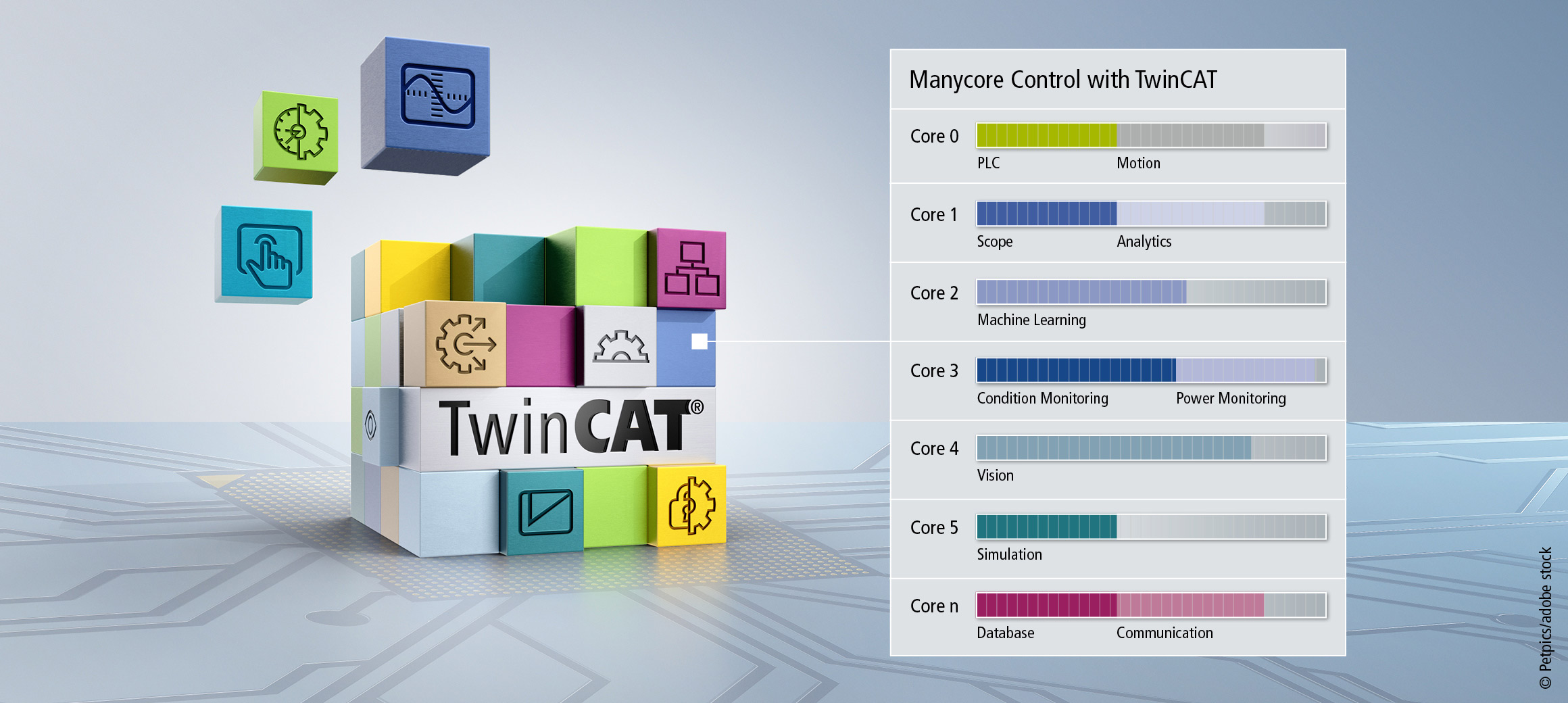

Scientific Automation describes the integration of a wide range of engineering knowledge into automation technology. Following this definition, Beckhoff has been developing powerful solutions since 2008 that show that much more than "just" standard automation is possible with a PC-based control platform. The strategy received particularly great attention in the context of the Industrie 4.0 discussion when, among other things, the German government gave the go-ahead for the innovation project ScAut – Scientific Automation with the Leading-Edge Cluster Intelligent Technical Systems Ostwestfalen Lippe (it's OWL) in 2012.
It is the combination of powerful Industrial or Embedded PCs, the highly deterministic Ethernet-based EtherCAT fieldbus system and the integrated TwinCAT control software that makes Scientific Automation possible. The classic areas of control technology, such as PLC, motion control and closed-loop control technology, are expanded with the ELM series I/O modules, among others, to include precise and fast measurement technology and engineering algorithms in TwinCAT.
The control software benefits from the constant performance increases in the PC sector. In TwinCAT, Beckhoff offers a software suite which is ideal to exploit this increased performance. The TwinCAT real-time environment is designed in such a way that almost any number of PLCs, safety controllers and C++ tasks can be executed on one or different CPU cores. This makes the finely scaled Industrial PC portfolio available to match the specific application requirements. For high-end applications, the CX20x2 series with Intel® Xeon® processors, with up to 12 cores, is DIN rail mountable. Alternatively, the cabinet mounted C60xx ultra-compact Industrial PC series offers the C6030, a device equipped with the latest generation Intel® Core™ i7 processor offering eight cores. For special applications, the C6670 control cabinet industrial server is available with up to 40 cores distributed across two Intel® Xeon® processors with over 1 TB main memory.
Standard control technology integrates additional functions
Until a few years ago, functionalities such as condition monitoring and complex robotics algorithms required a separate control system with specific programming and configuration tools. From the point of view of machine control, these systems were a stand-alone "black box". Today, they are available as completely transparent and fully integrated solutions within standard automation software. On a given control application, auto-tuning can even be performed for the drive axes of a robotics application using appropriate algorithms. Even speech input and output, as the most natural form of communication, are now part of TwinCAT and extend the standard automation functions. With TwinCAT Vision, image processing is also fully integrated into the automation technology – from configuration to programming in the PLC, where vision algorithms perform synchronous analysis of image data directly in real time. This eliminates the need for additional and costly communication of the image data to special vision systems and possible delays due to jitter. If required, image data can be reloaded into non-real-time applications and displayed graphically in the TwinCAT software oscilloscope Scope View, for example, to show how they are synchronized in time with other process data of the machine.
In addition to image data processing, there are other computationally and data-intensive functions such as data analytics and machine learning that have been implemented directly in TwinCAT. In this way, it is possible to use the TwinCAT Analytics Runtime (TF3550) to perform unsupervised clustering for anomaly detection in streaming data. Correlation and regression methods can also be configured very easily in engineering and executed in the runtime along with automatic PLC code and dashboard generation. In addition, neural networks can be loaded into the Neural Network Inference Engine (TF3810). These networks can be trained in almost any machine learning and deep learning framework and downloaded to TwinCAT real-time applications via a standardized exchange format such as ONNX. This makes it easy to implement optimization strategies, for example, with regard to production time, quality or energy consumption, directly on the control system. In the future, Scientific Automation will offer the possibility of loading prefabricated artificial intelligence models and automatically adapting them to the specific requirements of a process, depending on the application, by shaping an AI blank by data. Additionally, in the data science area, support for MATLAB® and Simulink® was established. Whether stand-alone or seamlessly integrated into TwinCAT Analytics, with TwinCAT Target for Simulink® (TE1400) or for MATLAB® (TE1401), numerous toolboxes such as signal processing, deep learning or parallel computing are available.
High IPC computing power enables local feature engineering
In addition to computing power, the performance of storage media is an essential aspect for vision, data analytics and machine learning scenarios. Entire database systems can be implemented directly on a suitable control computer. Applications can tap terabytes of local data or, in hybrid mode, parallel data streams from the cloud to create expert systems that make life easier for the end user. Large data quantities can be reduced by smart compression algorithms and loaded faster, not only to show the machine operator the history of the data, but also to evaluate it retrospectively. Not only is data pre-processing possible, but automatic feature evaluation directly on the control platform is also available. Today's advanced control computers even offer so many resources in the form of memory and CPU power that it is possible to implement a complete virtualization environment in the form of docker containers in addition to real-time support, and thus run cloud services directly on the local controller if necessary. The reverse scenario, in which the local controller autonomously communicates with its own avatar in the cloud, is also not ruled out.
Scientific Automation from Beckhoff is already available in real products and also offers sufficient potential for future developments and concepts. In addition to actual machine control, the focus is increasingly on engineering. TwinCAT Analytics, with its simple configuration interfaces and guided use, is a good example of how a powerful and complex scientific application does not always require complex configuration and programming.